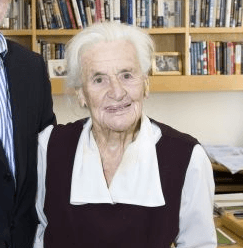Ines Mandl facts for kids
Quick facts for kids
Ines Mandl
|
|
|---|---|

fair use image only
|
|
| Born | 1917 Vienna
|
| Died | 2016 |
| Alma mater |
|
| Awards | Garvan-Olin Medal |
| Scientific career | |
| Fields | biochemistry |
| Institutions | Columbia University |
Ines Mandl (born April 4, 1917 – died August 5, 2016) was an amazing scientist. She was an Austrian-born American biochemist, which means she studied the chemistry of living things. Ines Mandl won the Garvan-Olin Medal in 1983. This award was for her important work on an enzyme called collagenase. She also taught as a professor at Columbia University.
Contents
Early Life and School Days
Ines Hochmuth was born in 1917 in Vienna, Austria. She was the only child of Ernst and Ida Hochmuth. Ines went to elementary and high school in Austria. Later, she married Hans Mandl and moved to London.
During World War II, she was in Ireland. There, she earned a special diploma in chemical technology from University College Cork. After the war, Ines moved to the United States. She continued her studies in chemistry. She earned her master's degree in 1947. Then, she completed her doctoral studies in 1949. This was at the Polytechnic Institute in Brooklyn, which is now part of New York University Tandon School of Engineering. She was one of the last students of Carl Neuberg, who is known as the "Father of Biochemistry."
A Career in Science
After getting her PhD in 1949, Ines Mandl started working at Columbia University. She joined the surgery department and stayed there for her whole career. In 1950, she made a big discovery. She was the first scientist to get the enzyme collagenase from a type of bacteria. This bacteria is called Clostridium histolyticum.
Her work also included studying breathing problems in newborn babies. She also researched the chemistry of a lung disease called pulmonary emphysema. Ines Mandl also taught microbiology. She wrote over 140 science papers with other researchers.
In 1972, Mandl started her own science magazine. It was called Connective Tissue Research. She was the editor of this journal from its very first issue. She continued as editor until she retired in 1986.
Awards and Recognition
Many people recognized Ines Mandl's important work. In 1977, she received the Carl Neuberg Medal. This award came from the American Society of European Chemists and Pharmacists. In 1983, she won the Garvan Medal from the American Chemical Society.
She also received the Austrian Cross of Honour for Science and Art. This is a very special award from Austria. Ines Mandl was also chosen to be a member of the American Academy of Arts and Sciences. She also joined the New York Academy of Sciences.
Her Lasting Impact
Ines Mandl gave a lot of money to her old school, New York University Tandon School of Engineering. This money helps students with scholarships and fellowships. These are for students studying chemical engineering and biological sciences.
In recent years, the enzyme collagenase has become very useful. Scientists are now finding many ways to use it in medicine. For example, it can help treat certain health problems.
In 2007, when Ines Mandl turned 90, a special event was held. The Ines Mandl Medical Foundation in Budapest held an award competition to celebrate her birthday.
Want to Learn More?

- In Spanish: Inés Mandl para niños

